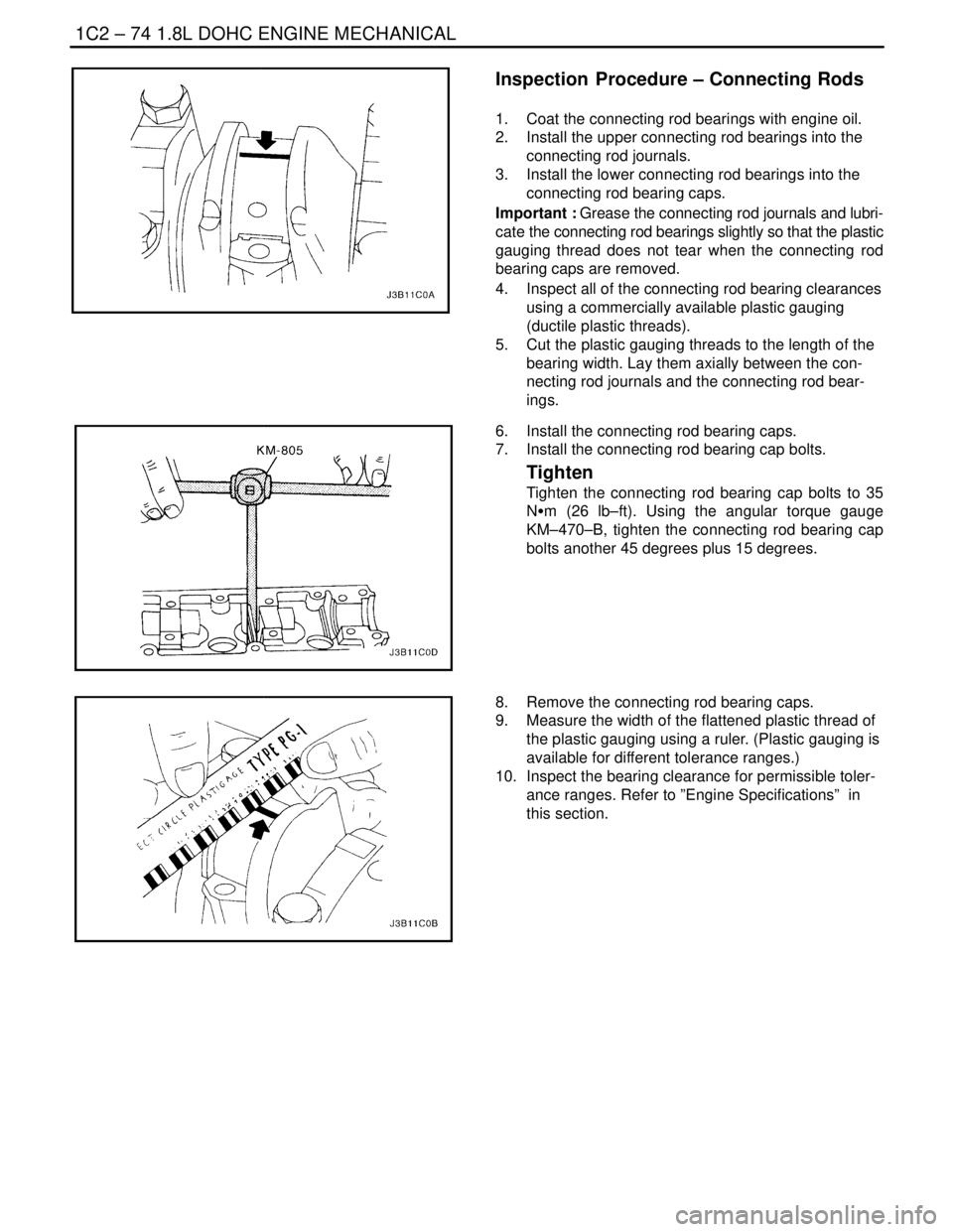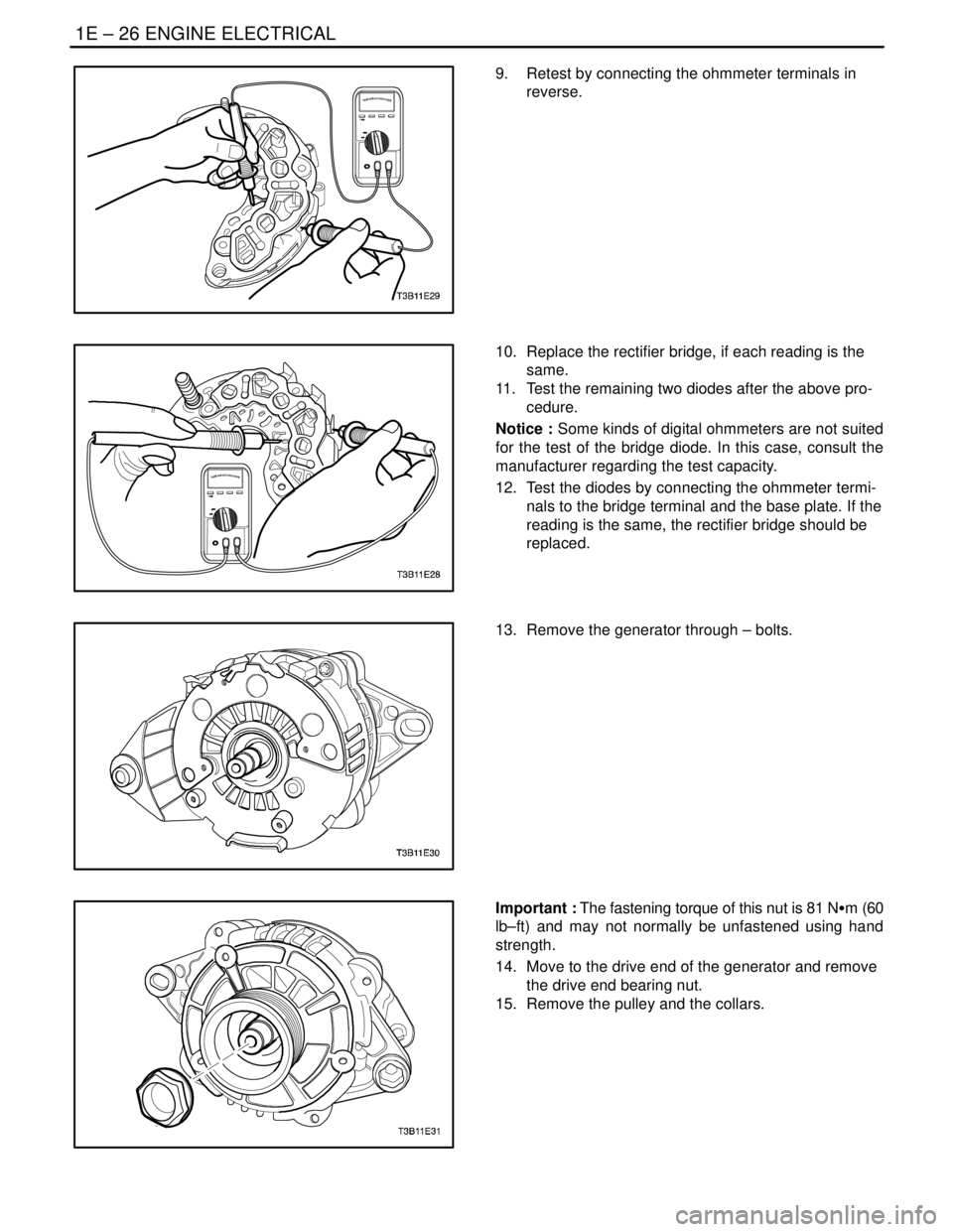2004 DAEWOO LACETTI torque
[x] Cancel search: torquePage 194 of 2643

1C2 – 74I1.8L DOHC ENGINE MECHANICAL
DAEWOO V–121 BL4
Inspection Procedure – Connecting Rods
1. Coat the connecting rod bearings with engine oil.
2. Install the upper connecting rod bearings into the
connecting rod journals.
3. Install the lower connecting rod bearings into the
connecting rod bearing caps.
Important : Grease the connecting rod journals and lubri-
cate the connecting rod bearings slightly so that the plastic
gauging thread does not tear when the connecting rod
bearing caps are removed.
4. Inspect all of the connecting rod bearing clearances
using a commercially available plastic gauging
(ductile plastic threads).
5. Cut the plastic gauging threads to the length of the
bearing width. Lay them axially between the con-
necting rod journals and the connecting rod bear-
ings.
6. Install the connecting rod bearing caps.
7. Install the connecting rod bearing cap bolts.
Tighten
Tighten the connecting rod bearing cap bolts to 35
NSm (26 lb–ft). Using the angular torque gauge
KM–470–B, tighten the connecting rod bearing cap
bolts another 45 degrees plus 15 degrees.
8. Remove the connecting rod bearing caps.
9. Measure the width of the flattened plastic thread of
the plastic gauging using a ruler. (Plastic gauging is
available for different tolerance ranges.)
10. Inspect the bearing clearance for permissible toler-
ance ranges. Refer to ”Engine Specifications” in
this section.
Page 195 of 2643

1.8L DOHC ENGINE MECHANICAL 1C2 – 75
DAEWOO V–121 BL4
GENERAL DESCRIPTION
AND SYSTEM OPERATION
CYLINDER HEAD AND GASKET
The cylinder head is made of an aluminum alloy. The cylin-
der head uses cross–flow intake and exhaust ports. A
spark plug is located in the center of each combustion
chamber. The cylinder head houses the dual camshafts.
CRANKSHAFT
The crankshaft has eight integral weights which are cast
with it for balancing. Oil holes run through the center of the
crankshaft to supply oil to the connecting rods, the bear-
ings, the pistons, and the other components. The end
thrust load is taken by the thrust washers installed at the
center journal.
TIMING BELT
The timing belt coordinates the crankshaft and the dual
overhead camshafts and keeps them synchronized. The
timing belt also turns the coolant pump. The timing belt
and the pulleys are toothed so that there is no slippage be-
tween them. There are two idler pulleys. An automatic ten-
sioner pulley maintains the timing belt’s correct tension.
The timing belt is made of a tough reinforced rubber similar
to that used on the serpentine drive belt. The timing belt
requires no lubrication.
OIL PUMP
The oil pump draws engine oil from the oil pan and feeds
it under pressure to the various parts of the engine. An oil
strainer is mounted before the inlet of the oil pump to re-
move impurities which could clog or damage the oil pump
or other engine components. When the crankshaft ro-
tates, the oil pump driven gear rotates. This causes the
space between the gears to constantly open and narrow,
pulling oil in from the oil pan when the space opens and
pumping the oil out to the engine as it narrows.
At high engine speeds, the oil pump supplies a much high-
er amount of oil than required for lubrication of the engine.
The oil pressure regulator prevents too much oil from en-
tering the engine lubrication passages. During normal oil
supply, a coil spring and valve keep the bypass closed, di-
recting all of the oil pumped to the engine. When the
amount of oil being pumped increases, the pressure be-
comes high enough to overcome the force of the spring.This opens the valve of the oil pressure regulator, allowing
the excess oil to flow through the valve and drain back to
the oil pan.
OIL PAN
The engine oil pan is mounted to the bottom of the cylinder
block. The engine oil pan houses the crankcase and is
made of cast aluminum.
Engine oil is pumped from the oil pan by the oil pump. After
it passes through the oil filter, it is fed through two paths
to lubricate the cylinder block and cylinder head. In one
path, the oil is pumped through oil passages in the crank-
shaft to the connecting rods, then to the pistons and cylin-
ders. It then drains back to the oil pan. In the second path,
the oil is pumped through passages to the camshaft. The
oil passes through the internal passageways in the cam-
shafts to lubricate the valve assemblies before draining
back to the oil pan.
EXHAUST MANIFOLD
A single four–port, rear–takedown manifold is used with
this engine. The manifold is designed to direct escaping
exhaust gases out of the combustion chambers with a
minimum of back pressure. The oxygen sensor is
mounted to the exhaust manifold.
INTAKE MANIFOLD
The intake manifold has four independent long ports and
utilizes an inertial supercharging effect to improve engine
torque at low and moderate speeds.
CAMSHAFTS
This engine is a dual overhead camshaft (DOHC) type,
which means there are two camshafts. One camshaft op-
erates the intake valves, and the other camshaft operates
the exhaust valves. The camshafts sit in journals on the
top of the engine (in the cylinder head) and are held in
place by camshaft caps. The camshaft journals of the cyl-
inder head are drilled for oil passages. Engine oil travels
to the camshafts under pressure where it lubricates each
camshaft journal. The oil returns to the oil pan through
drain holes in the cylinder head. The camshaft lobes are
machined into the solid camshaft to precisely open and
close the intake and the exhaust valves the correct
amount at the correct time. The camshaft lobes are oiled
by splash action from pressurized oil escaping from the
camshaft journals.
Page 199 of 2643

1D – 4IENGINE COOLING
DAEWOO V–121 BL4
COOLING SYSTEM DIAGNOSIS
Engine Overheats
ChecksAction
Check for a loss of the coolant.Add the coolant.
Check for a weak coolant solution.Confirm that the coolant solution is a 50/50 mixture of eth-
ylene glycol and water.
Check the front of the radiator for any dirt, any leaves, or
any insects.Clean the front of the radiator.
Check for leakage from the hoses, the coolant pump, the
heater, the thermostat housing, the radiator, the core
plugs, or the head gasket.Replace any damaged components.
Check for a faulty thermostat.Replace a damaged thermostat.
Check for retarded ignition timing.Perform an ECM code diagnosis. Confirm the integrity of
the timing belt.
Check for an improperly operating electric cooling fan.Replace the electric cooling fan.
Check for radiator hoses that are plugged or rotted.Replace any damaged radiator hoses.
Check for a faulty water pump.Replace a faulty water pump.
Check for a faulty surge tank cap.Replace a faulty surge tank cap.
Check for a cylinder head or an engine block that is
cracked or plugged.Repair the damaged cylinder head or the damaged engine
block.
Loss of Coolant
ChecksAction
Check for a leak in the radiator.Replace a damaged radiator.
Check for a leak in the following locations:
S Surge tank.
S Hose.Replace the following parts, as needed:
S Surge tank.
S Hose.
Check for loose or damaged radiator hoses, heater hoses,
and connections.Reseat the hoses.
Replace the hoses or the clamps.
Check for leaks in the coolant pump seal.Replace the coolant pump seal.
Check for leaks in the coolant pump gasket.Replace the coolant pump gasket.
Check for an improper cylinder head torque.Tighten the cylinder head bolts to specifications.
Replace the cylinder head gasket, if needed.
Check for leaks in the following locations:
S Intake manifold.
S Cylinder head gasket.
S Cylinder block plug.
S Heater core.
S Radiator drain plug.Repair or replace any components, as needed, to correct
the leak.
Engine Fails to Reach Normal Operating Temperature or Cool Air
from the Heater
ChecksAction
Check to determine if the thermostat is stuck open or is the
wrong type of thermostat.Install a new thermostat of the correct type and heat range.
Check the coolant level to determine if it is below the MIN
mark on the surge tank.Add sufficient coolant to raise the fluid to the specified
mark on the surge tank.
Page 240 of 2643

1E – 26IENGINE ELECTRICAL
DAEWOO V–121 BL4
9. Retest by connecting the ohmmeter terminals in
reverse.
10. Replace the rectifier bridge, if each reading is the
same.
11. Test the remaining two diodes after the above pro-
cedure.
Notice : Some kinds of digital ohmmeters are not suited
for the test of the bridge diode. In this case, consult the
manufacturer regarding the test capacity.
12. Test the diodes by connecting the ohmmeter termi-
nals to the bridge terminal and the base plate. If the
reading is the same, the rectifier bridge should be
replaced.
13. Remove the generator through – bolts.
Important : The fastening torque of this nut is 81 NSm (60
lb–ft) and may not normally be unfastened using hand
strength.
14. Move to the drive end of the generator and remove
the drive end bearing nut.
15. Remove the pulley and the collars.
Page 255 of 2643

ENGINE CONTROLS 1F – 9
DAEWOO V–121 BL4
Spark Advance
This is a display of the spark advance Ignition Coil (IC) cal-
culation which the ECM is programming in the ignition sys-
tem. It computes the desired spark advance using data
such as engine temperature, rpm, engine load, vehicle
speed and operating mode.
TCC Engaged
When the brake pedal is applied, the Torque Converter
Clutch (TCC) brake switch sends a signal to the ECM to
disengage the TCC and disable the cruise control.
Total Misfire Current Counter
Indicates the total number of misfires that have been de-tected in all the cylinders after 100 engine cycles. One
cycle equals one complete 4 stroke cycle. The total misfire
only increments during the steady state cruise conditions.
TP Sensor
The ECM uses the TP Sensor in order to determine the
amount of the throttle demanded by the vehicle’s operator.
The TP Sensor reads between 0.36–0.96 volts at idle to
above 4 volts at WOT.
Vehicle Speed
The vehicle speed sensor signal is converted into mph or
km/h for display. The vehicle speed output from the ECM
is 4000 pulses per mile. The scan tool uses the KWP 2000
serial data from the ECM to obtain vehicle speed, while the
Instrument Panel Cluster (IPC), cruise control module and
the chime alarm module use the 4000 ppm output.
Page 504 of 2643

1F – 258IENGINE CONTROLS
DAEWOO V–121 BL4
S Damaged terminals
S Poor terminal to wire connection
S Physical damage to the wiring harness
Ensure the VSS is correctly torqued to the trnasaxle hous-ing.
Refer to ”Intermittents” in this section.
DTC P0501 – Vehicle Speed No Signal (M/T Only)
StepActionValue(s)YesNo
1Perform an Euro On–Board Diagnostic (EOBD)
System Check.
Is the system check complete?–Go to Step 2Go to
”On–Board
Diagnostic Sys-
tem Check”
2Notice : Running the vehicle in gear with the wheels
hanging down at full travel will damage the drive
axles.
1. Turn the ignition ON, with the engine OFF.
2. Install a scan tool.
3. Raise the drive wheels.
4. Support the lower control arms so that the
drive axles are in a horizontal (straight) posi-
tion.
5. Allow the engine to idle in gear.
Does the scan tool display vehicle speed above the
specified value?0 mphGo to Step 3Go to Step 4
31. Turn the ignition ON, with the engine OFF.
2. Review the Freeze Frame data and note the
parameters.
3. Operate the vehicle within the Freeze Frame
conditions and Conditions for Setting this DTC.
Does the scan tool display the vehicle speed above
the specified value?0 mphGo to Step 12Go to Step 4
41. Turn the ignition OFF.
2. Disconnect the engine control module(ECM)
connector 51.
3. Using a digital voltmeter(DVM) connected to
ground, measure the voltage in the Vehicle
Speed Sensor (VSS) signal circuit, at terminal
C while rotating the wheels.
Is the voltage greater than or eqaul to specified val-
ue?0.5VGo to Step 12Go to Step 5
5Measure the resistant in the VSS signal circuit while
rotating the wheels.
Is the resistance greater than the specified value?1950WGo to Step 6Go to Step 7
6Check the VSS signal circuit for an open and repair
as necessary.
Is the repair complete?–Go to Step 12Go to Step 9
7Is the resistance value within or equal to the speci-
fied value?1300–1950WGo to Step 8Go to Step 9
8Check the VSS signal circuit for a short to ground or
for being shorted together and repair as necessary.
Is a repair necessary?–Go to Step 12Go to Step 12
91. Remove the VSS.
2. Measure the resistance between terminals A
and C.
Is the resistance value within the specified value?1300–1950WGo to Step 11Go to Step 10
Page 506 of 2643

1F – 260IENGINE CONTROLS
DAEWOO V–121 BL4
DIAGNOSTIC TROUBLE CODE (DTC) P0510
THROTTLE POSITION SWITCH CIRCUIT FAULT
(1.4L DOHC)
Circuit Description
The aim of the MTIA(Main Throttle Idle Actuator) is to con-
trol the idle speed with the throttle body itself. The throttle
is motorized for low opening angle (05, 195). The charac-
teristics of the air flow are not the same for low and high
opening angles. As a matter of fact, the gradient of the
mass air flow function of TP sensor is lower for small
angles that permits to be more precise during the idle
speed control. Out of idle speed the throttle is actuated
mechanically by a classical bowdencable.
This switch indicates throttle plate in idle position when
contact closed. This switch is fixed at the DC–motor drive
and the throttle plate closes the contact in dependence to
the actual motor drive position.
Conditions for Setting the DTC
S The engine stopped and ignition switch turned ON.
S DTCs P0122, P0123, P0222 and P0223 are not
set.
S MTIA output signal is highter than throttle position +
2.5° and throttle position is open at least 0.2 sec-
onds.
Or
S DTCs P0122, P0123, P0222, and P0223 are not
set.
S The throttle position output signal is greater than
30° and throttle position is closed at least 2 sec-
onds.
Action Taken When the DTC SetsS The Malfunction Indicator Lamp (MIL) will not illumi-
nate.
S The ECM will store conditions which were present
when the DTC was set as Failure Records data
only.
S This information will not be stored in the Freeze
Frame data.
Conditions for Clearing the MIL/DTC
S A history DTC will clear after 40 consecutive warm
up cycles without a fault.
S DTC(s) can be cleared by using the scan tool.
S Disconnecting the ECM battery feed for more than
10 seconds.
Diagnostic Aids
An Intermittent problem may be caused by a poor connec-
tion, rubbed through wire insulation, or wire that is broken
inside the insulation.
VSS signal circuit should be thoroughly checked for the
following conditions
S Backed–out terminals
S Improper mating
S Broken locks
S Improperly formed
S Damaged terminals
S Poor terminal to wire connection
S Physical damage to the wiring harness
Ensure the VSS is correctly torqued to the trnasaxle hous-
ing.
Refer to ”Intermittents” in this section.
Page 508 of 2643

1F – 262IENGINE CONTROLS
DAEWOO V–121 BL4
DIAGNOSTIC TROUBLE CODE (DTC) P0510
THROTTLE POSITION SWITCH CIRCUIT FAULT
(1.6L DOHC)
Circuit Description
The aim of the MTIA(Main Throttle Idle Actuator) is to con-
trol the idle speed with the throttle body itself. The throttle
is motorized for low opening angle (05, 195). The charac-
teristics of the air flow are not the same for low and high
opening angles. As a matter of fact, the gradient of the
mass air flow function of TP sensor is lower for small
angles that permits to be more precise during the idle
speed control. Out of idle speed the throttle is actuated
mechanically by a classical bowdencable.
This switch indicates throttle plate in idle position when
contact closed. This switch is fixed at the DC–motor drive
and the throttle plate closes the contact in dependence to
the actual motor drive position.
Conditions for Setting the DTC
S The engine stopped and ignition switch turned ON.
S DTCs P0122, P0123, P0222 and P0223 are not
set.
S MTIA output signal is highter than throttle position +
2.5° and throttle position is open at least 0.2 sec-
onds.
Or
S DTCs P0122, P0123, P0222, and P0223 are not
set.
S The throttle position output signal is greater than
30° and throttle position is closed at least 2 sec-
onds.
Action Taken When the DTC Sets
S The Malfunction Indicator Lamp (MIL) will illumi-
nate.S The ECM will record operating conditions at the
time the diagnostic fails. This information will be
stored in the Freeze Frame and Failure Records
buffers.
S A history DTC is stored.
S Coolant fan turns on.
Conditions for Clearing the MIL/DTC
S The MIL will turn off after four consecutive ignition
cycles in which the diagnostic runs without a fault.
S A history DTC will clear after 40 consecutive warm
up cycles without a fault.
S Using the scan tool can clear DTC(s).
S Disconnecting the ECM battery feed for 10 sec-
onds.
Diagnostic Aids
An Intermittent problem may be caused by a poor connec-
tion, rubbed through wire insulation, or wire that is broken
inside the insulation.
VSS signal circuit should be thoroughly checked for the
following conditions
S Backed–out terminals
S Improper mating
S Broken locks
S Improperly formed
S Damaged terminals
S Poor terminal to wire connection
S Physical damage to the wiring harness
Ensure the VSS is correctly torqued to the trnasaxle hous-
ing.
Refer to ”Intermittents” in this section.